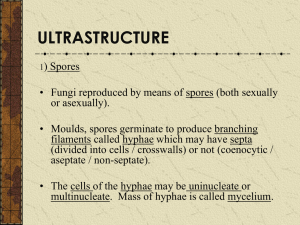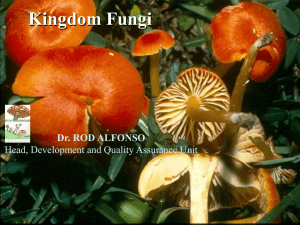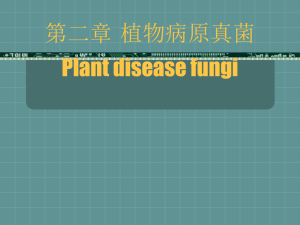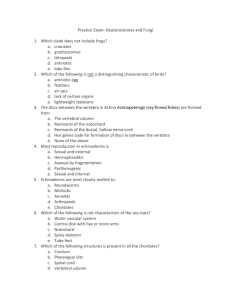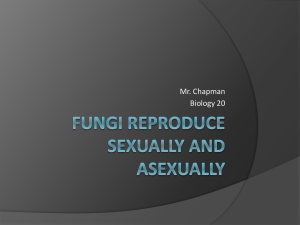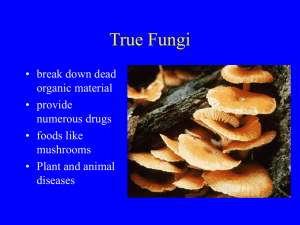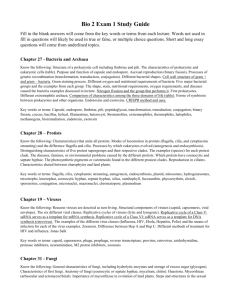File - Blinka Science!
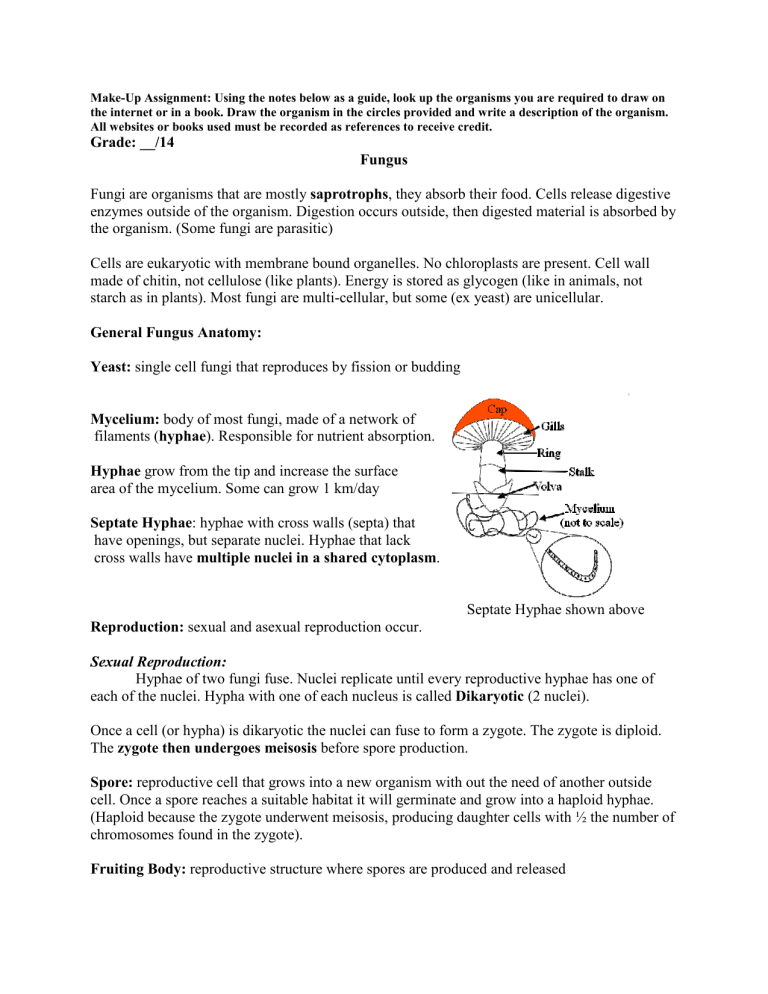
Make-Up Assignment: Using the notes below as a guide, look up the organisms you are required to draw on the internet or in a book. Draw the organism in the circles provided and write a description of the organism.
All websites or books used must be recorded as references to receive credit.
Grade: __/14
Fungus
Fungi are organisms that are mostly saprotrophs , they absorb their food. Cells release digestive enzymes outside of the organism. Digestion occurs outside, then digested material is absorbed by the organism. (Some fungi are parasitic)
Cells are eukaryotic with membrane bound organelles. No chloroplasts are present. Cell wall made of chitin, not cellulose (like plants). Energy is stored as glycogen (like in animals, not starch as in plants). Most fungi are multi-cellular, but some (ex yeast) are unicellular.
General Fungus Anatomy:
Yeast: single cell fungi that reproduces by fission or budding
Mycelium: body of most fungi, made of a network of
filaments ( hyphae ). Responsible for nutrient absorption.
Hyphae grow from the tip and increase the surface area of the mycelium. Some can grow 1 km/day
Septate Hyphae : hyphae with cross walls (septa) that
have openings, but separate nuclei. Hyphae that lack
cross walls have multiple nuclei in a shared cytoplasm .
Reproduction: sexual and asexual reproduction occur.
Septate Hyphae shown above
Sexual Reproduction:
Hyphae of two fungi fuse. Nuclei replicate until every reproductive hyphae has one of each of the nuclei. Hypha with one of each nucleus is called Dikaryotic (2 nuclei).
Once a cell (or hypha) is dikaryotic the nuclei can fuse to form a zygote. The zygote is diploid.
The zygote then undergoes meisosis before spore production.
Spore: reproductive cell that grows into a new organism with out the need of another outside cell. Once a spore reaches a suitable habitat it will germinate and grow into a haploid hyphae.
(Haploid because the zygote underwent meisosis, producing daughter cells with ½ the number of chromosomes found in the zygote).
Fruiting Body: reproductive structure where spores are produced and released
Aseuxal Reproduction:
1.
Specialized portion of mycelium produces spores without mating with another.
2.
Part of the mycelium breaks off and becomes a separate organism
3.
Budding (single cell fungi) such as yeast.
Classes of Fungi
( additional classes exist, however, we will not study them in lab)
*Zygospore Fungi (formerly Phycomycetae (algal fungi))
(From information found on pages 117-118 of Williams General Biology for Lecture and
Laboratory)
Phycomycetae: example: Rhizopus .
Observe the filamentous mold Rhizopus (black bread mold) in the petri dishes. Notices the mass of clear filaments intertwined to form a mycelium.
Is the magnification of the stereo microscope sufficient to determine if the hyphae are septate? If so, are the hyphae septate?
Three types of hyphae are associated with Rhizopus :
1.
Sporangiophores: filaments which extend out and bear large numbers of minute black spores
2.
Rhizoids – rootlike processes which become embedded within the food substrate on which the mold is growing.
3.
Stolons: filaments running parallel to the surface of the food.
Can you locate all of these hyphae types in your image(s)?
In the space below: sketch Rhizopus and write a description.
*Ascomycetae (sac fungi) - asexual and sexual species exist. Examples: Candida – yeasts that cause infections in humans, Penicillium , Trichophyton (aka athlete’s foot, ringworm, chestnut blight)
Asexual Reproduction : yeast: reproduce by budding
Others: produces spores called conidiospores – vary in size and shape.
Develop on tips of conidiophores. Conidiophores are specialized aerial hyphae. (Conidiophores differ in shape and are important in IDing these fungi). Spores are windblown.
Examples of asexual sac fungi – aka imperfect fungi – everything is not known about their reproductive process (the knowledge is imperfect, not the fungi!) Penicillium
Sexual Reproduction :
Ascus: finger-like sac produced during sexual reproduction. Spores are produced and mature here. When the ascus matures, it swells, spores are released.
Examples of sexual sac fungi – red bread molds and truffles.
In the space below provide an illustration and description of the Peziz, Penicillium, and
Morchella.
*Basidomycetes (club fungi) - Include Mushrooms (Portabella, Shiitake) , Rusts, Smuts, Bunts.
Mycellium have septate hyphae. Most are saprotrophs, some are parasitic.
Sexual Reproduction : (asexual production occasionally occurs, but is not the norm)
Fruiting Body: basidiocarp (mushroom in some cases)–contains basidium (1-4 celled), which are club-shaped structures where spores (basidiospores) develop.
Mushrooms: tightly packed hyphae
with ends that are walled off and become basidia where spores develop.
Basidia form on the gills of a mushroom.
Nuclei fusion occurs in basidia to
Form a zygote. Zygote undergoes meisosis to form basidiospores.
Parasitic Basidomycetes: Smuts, Rusts, and Bunts parasitize cereal crops (wheat, corn, oats, etc). Do not form basidiocarps. Smuts reside inside a host until maturity, but infest only one hosts. Rusts require alternating hosts.
In the space below illustrate and describe 3 Basidomycetes provided in class.
Be able to recognize: stink horn and bracket fungus.
Know the common names and that they are Basidiomycetes.
Fungi Questions
Grade:__/10
1.
How do fungi differ from protists and plants?
2.
Are fungi more closely related to plants or animals?
3.
What are the main steps in fungal SEXUAL reproduction?
Name: _________________
4.
What are the steps in fungal ASEXUAL reproduction?
5.
What is a fruiting body?
6.
Know the parts shown in the diagram below. Be prepared to label them from a diagram, specimen, or model. What fungi class is the illustrated organism a member of?
7.
What class of fungi includes the black bread mold Rhizopus ?
8.
What types of hyphae are associated with Rhizopus ?
9.
What class of fungi includes Peziz , Morchella , and Penicillium ?
10. Are slime molds members of the Fungi kingdom?

